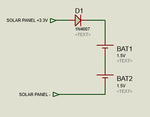pic.programmer
Advanced Member level 3
Can I use this circuit to charge the 1.5 V Ni-Mh batteries using this solar panel ?
https://robokits.co.in/solar-panels/solar-panel-3v-200ma-for-diy-projects
I am referring to this circuit. It uses 2.4V Solar Panel and he uses two diodes and so 1.4V is dropped. So, is he charging the battery with 1V ?
What happens if a 1.5V battery is charges with a solar panel voltage of 2.3 V or 2.6 V ?
I need to charge two batteries in series. Should I use 2 x Solar panels of 3.3V in Series ?
Twi 1.5V batteries are in series and I am using NCP1402 circuits to get 5V and 3.3V 200 mA. 5V from booster powers Ultrasonic sensor and ATMega328P and 3.3V powers nRF24L01.
The quiscent current of NCP1402 circuit is 1 mA. Can I get any better device whose quiscent current is less than 1 mA and which can provide 3.3V and 5V 200 mA from 2 to 3V input. I will use two such circuits to get 3.3V and 5V.
- - - Updated - - -
Edit:
Can I use this solar panel (6V 200 mA)
https://robokits.co.in/solar-panels/solar-panel-6v-200ma-for-diy-projects
to charge two Ni-Mh batteries in Series ? I will use 1 or 2 IN4007 diode in series to drop the voltage. What should be the charging voltage to provide across the two series 1.5V batteries ?
https://robokits.co.in/solar-panels/solar-panel-3v-200ma-for-diy-projects
I am referring to this circuit. It uses 2.4V Solar Panel and he uses two diodes and so 1.4V is dropped. So, is he charging the battery with 1V ?
What happens if a 1.5V battery is charges with a solar panel voltage of 2.3 V or 2.6 V ?
I need to charge two batteries in series. Should I use 2 x Solar panels of 3.3V in Series ?
Twi 1.5V batteries are in series and I am using NCP1402 circuits to get 5V and 3.3V 200 mA. 5V from booster powers Ultrasonic sensor and ATMega328P and 3.3V powers nRF24L01.
The quiscent current of NCP1402 circuit is 1 mA. Can I get any better device whose quiscent current is less than 1 mA and which can provide 3.3V and 5V 200 mA from 2 to 3V input. I will use two such circuits to get 3.3V and 5V.
- - - Updated - - -
Edit:
Can I use this solar panel (6V 200 mA)
https://robokits.co.in/solar-panels/solar-panel-6v-200ma-for-diy-projects
to charge two Ni-Mh batteries in Series ? I will use 1 or 2 IN4007 diode in series to drop the voltage. What should be the charging voltage to provide across the two series 1.5V batteries ?
Attachments
Last edited:
